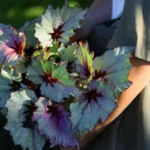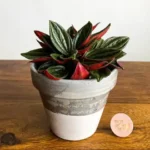Meet Calathea Orbifolia: A Striking Addition to Your Indoor Jungle
Calathea orbifolia is one of the most stunning houseplants you can add to your indoor collection. Loved for its extra-large, oval-shaped foliage with soft silver and green striped patterns, this tropical beauty hails from the rainforests of Bolivia. While its appearance is dramatically ornamental, Calathea orbifolia requires a bit of careful attention to keep it healthy and thriving. Fortunately, with a little understanding of its natural habitat and preferences, even novice plant parents can enjoy its beauty.
Understanding the Needs of Calathea Orbifolia
Watering: Keep It Consistent, But Not Excessive
Calathea orbifolia prefers evenly moist soil but is sensitive to overwatering. This balance can be a bit tricky, but once you’ve established a rhythm, your plant will reward you with vibrant growth. Here are a few key watering tips:
- Water when the top 1-2 inches of soil feel dry to the touch.
- Use filtered or distilled water if your tap water is hard or contains fluoride or chlorine—Calathea is sensitive to chemicals.
- Keep the soil consistently moist, but never soggy. Ensure your pot has good drainage.
- Reduce watering frequency during colder months but never let the soil fully dry out.
Light: Bright, Indirect Light Works Best
In its native rainforest habitat, Calathea orbifolia grows beneath the tree canopy, thriving in dappled light. Mimicking this lighting indoors is essential:
- Place your plant near a north- or east-facing window where it receives bright but indirect sunlight.
- Avoid direct sun exposure, which can scorch its leaves and fade its signature silver stripes.
- Artificial grow lights can be helpful, especially in dim rooms or during winter months.
Humidity: High Humidity Is Key
Maintaining high humidity is one of the most important care factors for Calathea orbifolia. Its broad leaves respond dramatically to dry air, often curling or browning at the edges. Here’s how to increase humidity:
- Keep it in a naturally humid room, such as a bathroom with filtered light.
- Use a humidifier to maintain humidity levels between 50% and 70%.
- Group it with other tropical plants to create a microclimate.
- A pebble tray under the plant can also help increase humidity through evaporation.
Soil: Well-Draining and Rich in Organic Matter
Your Calathea orbifolia will thrive in a loose, well-aerated soil mix that retains some moisture without becoming compacted. A good mix can include:
- 2 parts peat moss or coco coir for moisture retention and acidity
- 1 part perlite for drainage
- 1 part compost or worm castings for rich nutrients
A specialized aroid mix (commonly used for philodendrons and monsteras) may also work well with some adjustment toward moisture retention.
Routine Maintenance and Troubleshooting
Fertilizing Tips
Calathea orbifolia isn’t a heavy feeder, but routine feedings can promote growth during the spring and summer. Here’s what to keep in mind:
- Use a diluted, balanced liquid fertilizer (10-10-10 or 20-20-20) once a month during the growing season.
- Avoid over-fertilizing, which can burn the roots and lead to curled or browning leaves.
- Flush the soil every few months with plain water to prevent salt buildup.
Dealing with Common Problems
Calathea orbifolia communicates well through its leaves—when something’s off, it’ll show. Here are a few issues plant lovers may encounter:
- Leaves curling or crispy edges: Usually caused by low humidity or inconsistent watering.
- Yellow leaves: May indicate overwatering or poor drainage. Check the roots for signs of rot.
- Brown spots: This can result from too much direct sun or chemical-laden water.
- Stunted growth: Could be due to poor lighting or nutrient deficiencies.
Regularly wiping the leaves with a damp cloth helps the plant breathe better and keeps it looking pristine. It also gives you a chance to inspect for pests like spider mites or fungal spots.
Repotting and Growth Habit
Calathea orbifolia isn’t a very fast-growing plant, but over time, it will outgrow its pot due to its expanding rhizomes. Consider repotting every 1–2 years in early spring:
- Select a pot that is one size up from the current one with drainage holes.
- Refresh the soil entirely; old soil can become compacted and depleted of nutrients.
- Gently divide the root ball if it’s too dense, but only if absolutely necessary.
Don’t worry if your plant seems slow to grow during winter—this is natural dormancy. Just continue light care, and it will pick up growth again in spring.
Creating the Right Environment at Home
To truly help your Calathea orbifolia thrive, consider the environment holistically. Think about light, water, temperature, and air quality together. Here are practical lifestyle-friendly ways to make your space more plant-compatible:
- Use sheer curtains to diffuse harsh light from sunny windows.
- Set reminders for watering and humidity checks using smartphone apps.
- Place the plant on a plant stand for airflow or next to a stylish humidifier to keep things functional and beautiful.
- Avoid placing it near air conditioners or radiators that can rapidly dry the air or cause temperature swings.
Why Calathea Orbifolia Is Worth the Effort
Though it asks for a bit more attention than your average succulent, Calathea orbifolia is a rewarding companion for houseplant aficionados. Its large, reflective leaves offer immediate visual impact, and watching it open and close its leaves in response to light (a trait known as nyctinasty) is a joy for any plant lover.
More than just aesthetics, caring for this plant cultivates a deeper connection with your indoor garden. It invites you to slow down, pay attention, and learn the rhythms of plant life.
Conclusion: A Plant with Beauty and Personality
Calathea orbifolia is a showstopper in any plant collection, offering lush greenery and striking patterns without requiring intense lighting conditions. By providing the right balance of moisture, humidity, and gentle light, you can help your orbifolia thrive and become a lasting presence in your indoor haven. For beginner gardeners willing to learn and adapt, this plant can be both forgiving and immensely satisfying. As you give care, it rewards you not just with healthy growth, but with a soothing green companion that brings life to your space.
References
- Carpio, W. A., & Porras, M. (2023). Indoor Tropical Plants: Care, Maintenance and Environmental Benefits. Greenhouse Publications.
- Rodale, J. I. (2021). Houseplants for a Healthy Home: 50 Indoor Plants to Help You Breathe Better, Sleep Better, and Feel Better All Year Round. Rodale Books.
- Smith, D. E. (2022). The Complete Guide to Plant Care. Urban Botany Press.








